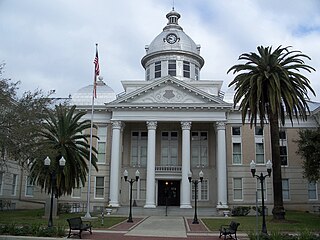
The Seminole Wars, also known as the Florida Wars, were three conflicts in Florida between the Seminole, a Native American tribe that formed in Florida in the early 18th century, and the United States Army. Both in human and monetary terms, the Seminole Wars were the longest and most expensive of the Indian Wars in United States history.

Fort Rucker is a U.S. Army post located primarily in Dale County, Alabama, United States. It was named for a Civil War officer, Confederate General Edmund Rucker. The post is the primary flight training installation for U.S. Army Aviators and is home to the United States Army Aviation Center of Excellence (USAACE) and the United States Army Aviation Museum. Small sections of the post also lie in Coffee, Geneva, and Houston counties. Part of the Dale County section of the base is a census-designated place; its population was 4,636 at the 2010 census.

Fort Meade is a city in Polk County, Florida, United States. The population was 5,691 at the 2000 census. As of 2004, the population recorded by the U.S. Census Bureau is 5,761. It is part of the Lakeland–Winter Haven Metropolitan Statistical Area. The city was named for George Meade, at the time an Army lieutenant serving in Florida following the Second Seminole War. Fort Meade is home to Fort Meade Middle-Senior High School, several historic buildings, Streamsong resort and Patterson Park. The area is popular with kayakers and canoers.
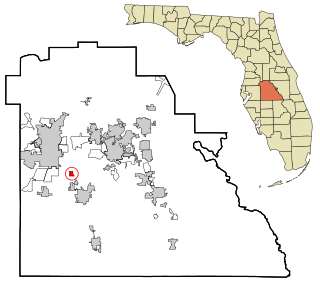
Highland City is a census-designated place (CDP) in Polk County, Florida, United States. The population was 2,051 at the 2000 census. It is part of the Lakeland–Winter Haven Metropolitan Statistical Area.

Brackettville is a city in Kinney County, Texas, United States. The population was 1,876 at the 2000 census. It is the county seat of Kinney County. Brackettville claims it is the drive-in movie capital of Texas.

Osceola, named Billy Powell at birth in Alabama, became an influential leader of the Seminole people in Florida. Of mixed parentage, including Creek, Scottish, African American, and English, he was considered born to his mother's people in the Creek matrilineal kinship system. He was reared by her in the Creek tradition. When he was a child, they migrated to Florida with other Red Stick refugees after their group's defeat in 1814 in the Creek Wars. There they became part of what was known as the Seminole people.

The Second Seminole War, also known as the Florida War, was a conflict from 1835 to 1842 in Florida between various groups of Native Americans collectively known as Seminoles and the United States, part of a series of conflicts called the Seminole Wars. The Second Seminole War, often referred to as the Seminole War, is regarded as "the longest and most costly of the Indian conflicts of the United States."
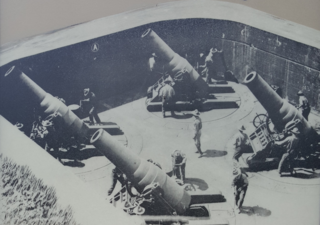
Fort Slocum, New York was a US military post which occupied Davids' Island in the western end of Long Island Sound in the city of New Rochelle, New York from 1867 to 1965. The fort was named for Major General Henry W. Slocum, a Union corps commander in the American Civil War.
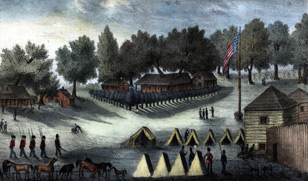
Fort Brooke was a historical military post situated on the east bank of the Hillsborough River in present-day Tampa, Florida. The fort was established in 1824, soon after Florida was acquired by the United States from Spain. It was an important post during the Seminole Wars and of lesser importance during the United States Civil War. It was decommissioned in 1883, and the land was eventually sold to private interests.
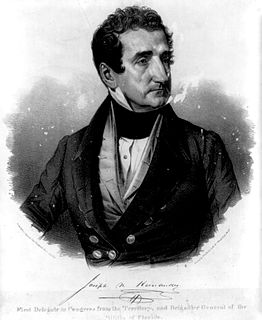
José Mariano Hernández or Joseph Marion Hernández was an American politician, plantation owner, and soldier. He was the first Delegate from the Florida Territory and the first Hispanic American to serve in the United States Congress. A member of the Whig Party, he served from September 1822 to March 1823.

Fort Dallas was a military base during the Seminole Wars, located on the banks of the Miami River in what is now downtown, Miami, Florida, United States.
Fort Maitland was a military fort built by the United States Army at what is now Maitland, Florida. It was built in November 1838 as a supply depot during the Second Seminole War. The fort was named after Captain W. S. Maitland, who was injured during the Battle of Wahoo Swamp and later killed himself after 9 months of trying to recover from his injuries.
The Treaty of Payne's Landing was an agreement signed on 9 May 1832 between the government of the United States and several chiefs of the Seminole Indians in the Territory of Florida, before it acquired statehood.

Fort King was a United States military fort in north central Florida, near what later developed as the city of Ocala. It was named after Colonel William King, commander of Florida's Fourth Infantry and the first governor of the provisional West Florida region.
The Battle of Fort Myers was fought on February 20, 1865, in Lee County, Florida during the last months of the American Civil War. This small engagement is known as the "southernmost land battle of the Civil War."
John Ward was a Black Seminole who served as a United States Army Indian Scout and received America's highest military decoration—the Medal of Honor—for his actions in the Indian Wars of the western United States.

Fort Christmas was built in present-day Christmas, Florida during the Second Seminole War. Construction began on December 25, 1837, with the arrival of 2,000 U.S. Army soldiers and Alabama volunteers.

Events from the year 1818 in the United States.

Fort Clark was a frontier fort located just off U.S. Route 90 near Brackettville, in the county of Kinney, in the U.S. state of Texas. It later became the headquarters for the 2nd Cavalry Division. The Fort Clark Historic District was added to the National Register of Historic Places on December 6, 1979. The Commanding Officer's Quarters at Fort Clark was designated a Recorded Texas Historic Landmark in 1988. The Fort Clark Guardhouse became a Recorded Texas Historic Landmark in 1962. The Fort Clark Officers' Row Quarters was designated a Recorded Texas Historic Landmark in 1991.
Fort Scott was built in 1816 on the west bank of the Flint River, where it joins the Chattahoochee River to form the Apalachicola, in the southwest corner of Georgia. It was named for Lt. Richard W. Scott, killed in the Scott Massacre of 1817 and never known to have visited the Fort. The need for a fort became evident during the War of 1812, when the British identified this undefended United States border, and in 1814 built two forts on the Apalachicola River, into which the Flint River flows: a strong fort at Prospect Bluff and a smaller one, Nicolls' Outpost, at the river juncture. This was in Spanish Florida, but Spain had neither the resources nor the inclination to do anything about this fort in a location to them remote.


